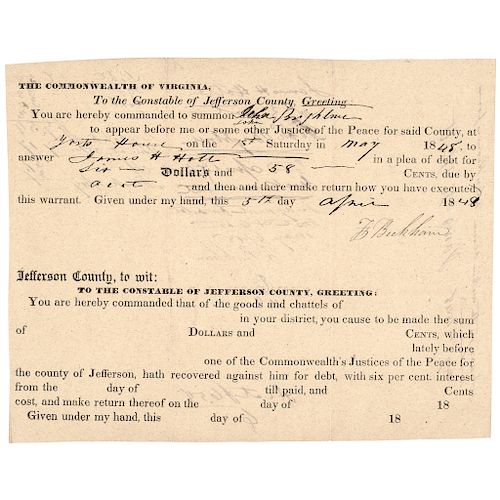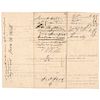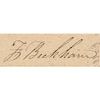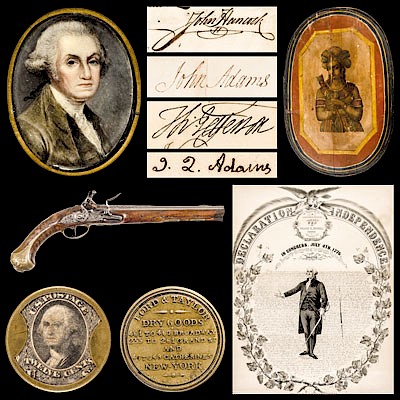1848 (JOHN BROWN) HARPERS FERRY RAID Various Participants SIGNED Document
Lot 221
Estimate:
$1,800 - $2,200
Absentee vs Live bid
Two ways to bid:
- Leave a max absentee bid and the platform will bid on your behalf up to your maximum bid during the live auction.
- Bid live during the auction and your bids will be submitted real-time to the auctioneer.
Bid Increments
| Price | Bid Increment |
|---|---|
| $0 | $10 |
| $200 | $20 |
| $300 | $25 |
| $500 | $50 |
| $1,000 | $100 |
| $2,000 | $200 |
| $3,000 | $250 |
| $5,000 | $500 |
| $10,000 | $1,000 |
| $20,000 | $2,000 |
| $30,000 | $2,500 |
| $50,000 | $5,000 |
| $100,000 | $10,000 |
| $200,000 | $20,000 |
| $300,000 | $25,000 |
| $500,000 | $50,000 |
About Auction
By Early American History Auctions
Jun 1, 2019
Set Reminder
2019-06-01 12:00:00
2019-06-01 12:00:00
America/New_York
Bidsquare
Bidsquare : Historic Autographs, Colonial Currency, Political Americana & Revolutionary War Era
https://www.bidsquare.com/auctions/early-american-history-auctions/historic-autographs-colonial-currency-political-americana-revolutionary-war-era-4152
Historic Autographs, Coins, Currency, Political, Americana, Historic Weaponry and Guns, John Adams, Thomas Jefferson, Early American History Auctions auctions@earlyamerican.com
Historic Autographs, Coins, Currency, Political, Americana, Historic Weaponry and Guns, John Adams, Thomas Jefferson, Early American History Auctions auctions@earlyamerican.com
- Lot Description
Civil War
1848 John Brown's Harpers Ferry Raid Related Document
Signed by Fontaine Beckham - The Harper's Ferry Mayor Killed
(HARPER'S FERRY RAID by JOHN BROWN): Harper's Ferry Battle Participants From Virginia.
April 5, 1848-Dated Important Pre-Civil War Era, Partially-Printed Document, Signed Twice (front and back), by Fontaine Beckham, Mayor of Harper's Ferry who was killed by John Brown's men during the famous Raid on Harpers Ferry, also Signed on the reverse by James H. Holt, who captured one of Brown's men John L. Copeland (a Free Black), during that Raid, Choice Extremely Fine. It is said that Holt put a gun to Copeland's head when captured. He fired the gun but the powder was wet and the gun failed to discharge. After pistol whipping Copeland, Holt dragged him ashore and with others, tried to Lynch Copeland with a rope made of handkerchiefs tied together, but was prevented from carrying it out. Copeland was tried and hanged two months later.
A historic, 1 page, Official Document that is very boldly printed on period wove paper. It fully completed where required in easily readable, deep rich brown ink, having excellent clear signatures, being only folded for storage. It is a legal Court Summons of Jefferson County, VA (now West Virginia) to bring John Brighton to court to answer for a debt of $6.58 owed by Brighton to James H. Holt.
This Document is Signed Twice, by Fontaine Beckham, Mayor of Harper's Ferry (on its front and back), who was killed by John Brown's men during the raid on Harpers Ferry. Fontaine Beckham was the third of the five men killed, and was also the most prominent. He was killed along the railroad, near a watering station. Besides being the Mayor at the time of the raid, he was a County Magistrate (in which capacity he signs this document), and a Station Agent for the B & O Railroad. Beckham's death so infuriated the towns people that they seized one of John Brown's men who had been captured, and riddled his body with bullets.
This Document is also Signed Twice on its reverse side by George Koonce (1818-1908), who served the summons, indicating that he had executed the writ and that the debt owed to Holt was being assigned to him. Koonce also had a noted role in defending Harper's Ferry shortly after the Civil War broke out.
On April 18, 1861, Harpers Ferry was approached by 2,000 Virginia soldiers. The Armory was only guarded by 42 Regular U.S. Army soldiers. Koonce responded to a request for help by the officer and led some local militia in stopping the larger Virginia Army at Smallwood's Ridge, near Bolivar. This gave time for the Union Officer to burn the arsenal and the armory. Koonce and his men fled North and didn't return again to Harpers Ferry until the Union again got control of the town in 1862. Koonce lost his home and his business as a result of his involvement in the April 1861 fight. After returning, he operated a general store in Harper's Ferry with a Mr. Horner from 1863 to 1864. Following the war, Koonce served as a Member of the West Virginia House of Delegates (1865-1867) and a Member of the West Virginia Senate (1870-1871). This unique document that would fit into any collection of John Brown, Harper's Ferry Raid, Abolition, Black History, or Civil War, signed historic documents.
- Shipping Info
-
Early American provides in-house worldwide shipping. Please contact us directly if you have questions about your specific shipping requirements.
-
- Buyer's Premium



 EUR
EUR CAD
CAD AUD
AUD GBP
GBP MXN
MXN HKD
HKD CNY
CNY MYR
MYR SEK
SEK SGD
SGD CHF
CHF THB
THB













